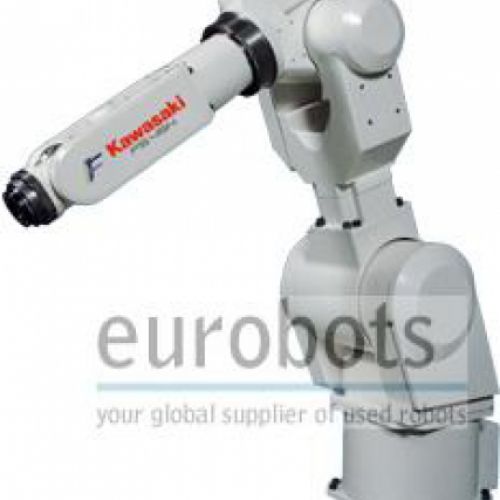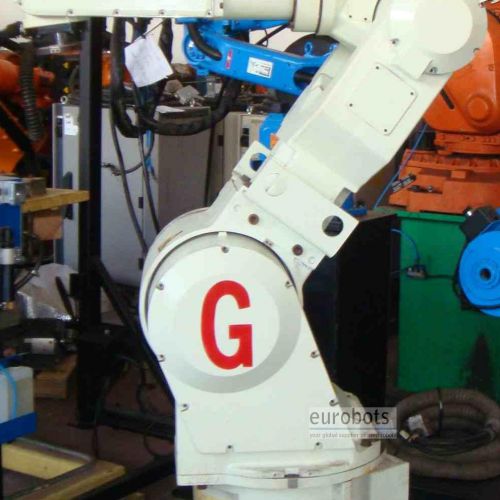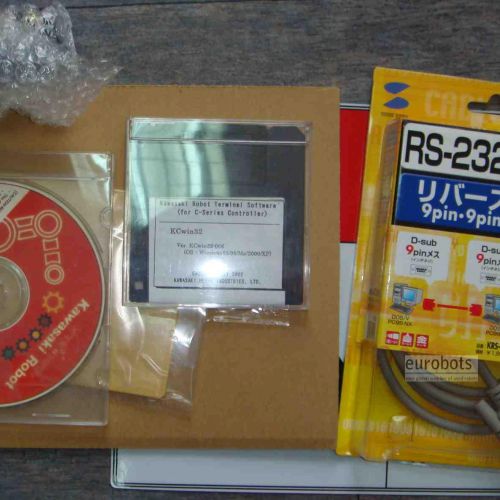Year 2004. Very few working hours. Equipped with the latest D controller. The F-Series Robots can reduce your production cycle times. High speeds are achieved through the use of compact high-output motors and high-efficient reduction gears, all housed within the F-Series lightweight arm construction. The F-Series Robots, combined with the ultra-high processing speeds of the Kawasaki D Controller, achieve industry leading acceleration and deceleration rates while maintaining smooth and efficient operation.
Small and Compact Design
The F-Series Robots excel in confined work zones. Manufacturing facilities are constantly striving to optimize floor space in an effort to increase efficiencies. The robot pedestal houses the joint one motor / encoder providing the F-Series Robots with one of the smallest footprints in its class. Internal pneumatic lines and signal wiring is standard on most F-Series Robots, reducing the need for bulky external harnesses. The F-Series small footprint and slim design, coupled with a simple vertical arm configuration, allows engineers and designers to create automated work cells while utilizing a minimum amount of floor space.
Configured to meet most any light to medium payload application
From welding, to wash down, to clean room applications; Kawasaki has a F-Series robot to match your needs. The lineup is comprised of several platforms utilizing modular components allowing for the unique ability to make changes to the arm configuration to increase / reduce reach and / or payload. All F-Series robots are designed for wall, ceiling, and floor mounting, enabling complete flexibility in system design.
Standard Features
-Six-Axis Articulated Arm -Payload Capacity 45 kg -Electric AC Servo Drive Motors/Encoders -Common D Controller -Large Working Envelope -Heavy-Duty Cycle · High wrist torque and inertia capacity · Maximum payload capacity rated at full speed and full reach -Space Saving Design · Small footprint · Slim arm construction · Integrated pneumatic lines and signal harness · Minimal dead zones -Production Advantages · Variety of reach and payload configurations · Modular arm design · High speed operation · Rapid and adaptive acceleration and deceleration rates · Protection rating Wrist IP67 (Arm IP65) -Low-Cost Maintenance · Greater than 80,000 hours MTBF · 5,000 hour maintenance intervals · Fittings for simple lubrication · Modular components for quick repairs -Programming · Simplified “Block Step” teaching · Advanced Kawasaki “AS Language” · RS-232 port for PC communication · Menu driven software · Technically advanced D Controller · On-screen diagnostics -Safety · Three-Position Teach Pendant Safety Switch · Hard stops and software limits · UL approved
D CONTROLLER SPECIFICATIONS
Ergonomic operation
The Teach Pendant (TP) is a combination of control keyboard and an easy-read, 6.4 inch colour LCD touch- screen. A new hardware structure for the TP reduces the key response time and the ergonomic arrangement of the keys helps the operator achieve optimised inputs and programming. The workflow is optimised and the TP becomes an ergonomic user platform for operating the robot Special software combined with standards Application Software Modules facilitate programming for a wide range of applications such as palletising, handling, spot welding, gluing and arc welding. The simplified block programming and Kawasaki‘s high level robot language (AS-language) provides enormous possibilities for innovative movement- and process control. Using the available options – such as servo-welding, network support and a high-performance visualisation system – a platform is created to find flexible solutions for even the most complex of applications.
High performance through modern control technology
A RISC, 64-bit high-speed dual processor provides the computing power. The use of a fully digitally controlled servo-system has significantly improved operating performance, cycle time and path accuracy. The controller is of course fully downwardly compatible. This means that the D controller can be integrated in existing old systems with no problems.
Control design
• Connection of peripheral equipment
Standard I/O connections and a number of field bus interfaces such as Interbus, Profibus, CC-Link and DeviceNet etc. are available as interfaces to the peripheral equipment. The peripheral equipment is connected directly and permits the system‘s high flexibility. Furthermore, K-Logic (integrated software PLC) allows the creation of a highly complex Integrated system at a minimum cost.
• Network communication
The controller also supports network communication via Ethernet to communicate with a host computer and for an easy upload and download of the programs to be run. Furthermore, the status of the robot can be monitored per remote access via an Intranet/Internet connection.
• Extension with additional axes
A further two axes can be integrated in the standard controller without any problems and without an additional housing. Three or more additional axes are available by selecting SSCNET-compatible motors. This allows multi-axial systems to be easily configured to match the customer‘s requirements.
• User-friendly design
A reduction of the controller‘s internal wiring and the use of modular assemblies facilitates servicing and ensures shorter working times when repairing or replacing parts with no long and costly downtimes. What‘s more, supporting service functions such as data storage help the user locate the causes of existing problems.
Robot Info:
- Maximum Load of Robot: 45Kg.
- Maximum Reach: 1970 mm.
- Repeatability: 0,15 mm.
- Controller: D
Robot Motion Speed:
- Axis 1: 160º/seg
- Axis 2: 140º/seg
- Axis 3: 150º/seg
- Axis 4: 240º/seg
- Axis 5: 340º/seg
- Axis 6: 340º/seg
Robot Applications:
- Machining
- Machine tending
- Polishing, grinding and deburring
- Coating and bonding
- Handling
- Measuring and testing
- Assembly
- Palletizing and order picking
- Cutting
- Welding
Applications
Arc welding , Palletising , Painting , Loading and unloading of parts , Machining , Handling of parts , Polishing
Pictures
Videos
Diagrams









